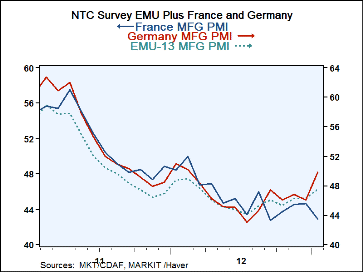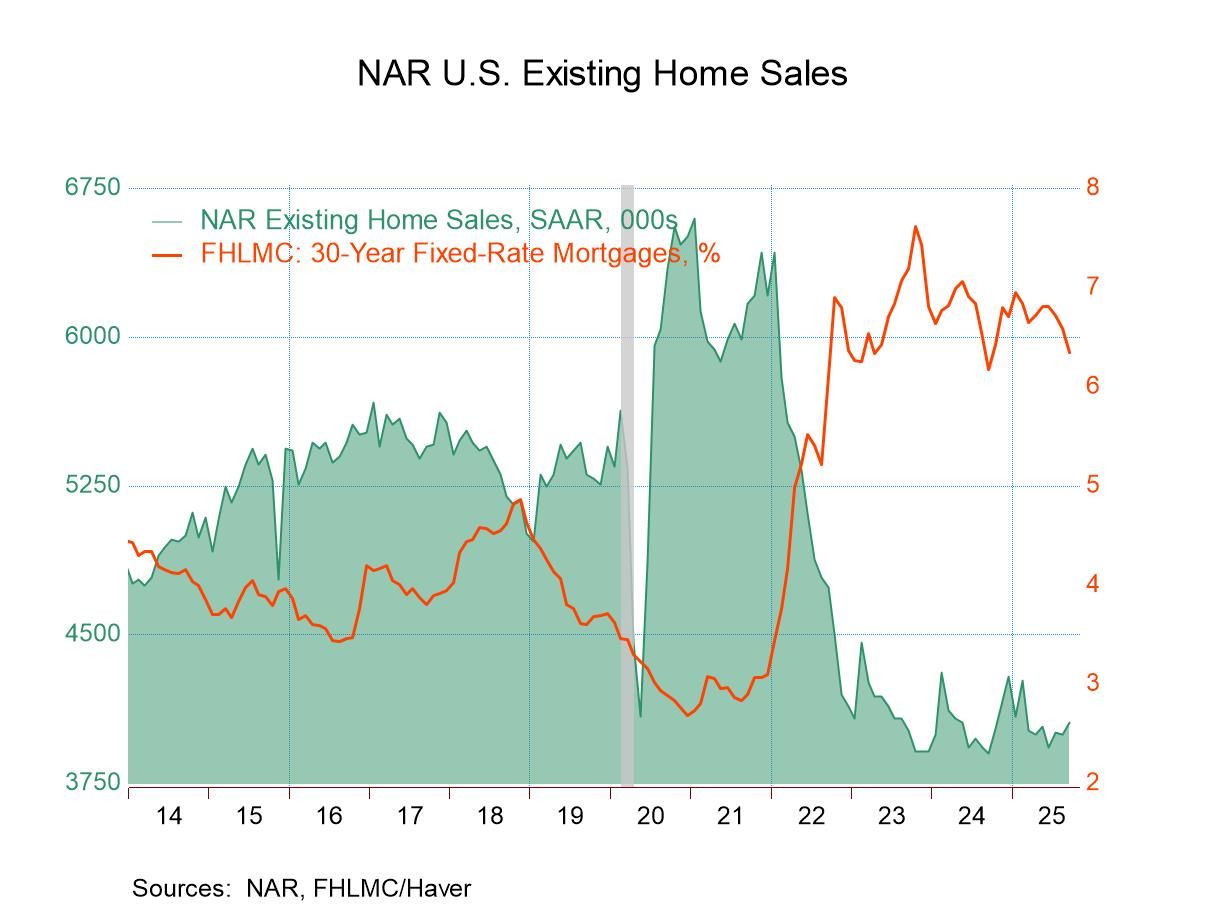 Global| Feb 01 2013
Global| Feb 01 2013European MPIs: JAWS!
Summary
The chart shows the latest twist in EMU. The recent observations plot a picture that looks like a snake with its mouth open, sticking out its green tongue. We have achieved this graphic design without using members from the periphery [...]
 The chart shows the latest twist in EMU. The recent observations plot a picture that looks like a snake with its mouth open, sticking out its green tongue. We have achieved this graphic design without using members from the periphery but by plotting the MFG PMI for Germany whose PMI is rising fast, France where the PMI is still falling fast and EMU itself, where slow weighted-average progress is in train.
The chart shows the latest twist in EMU. The recent observations plot a picture that looks like a snake with its mouth open, sticking out its green tongue. We have achieved this graphic design without using members from the periphery but by plotting the MFG PMI for Germany whose PMI is rising fast, France where the PMI is still falling fast and EMU itself, where slow weighted-average progress is in train.
France, Ireland and Denmark are the only three countries in EMU for which we have detailed observations for the manufacturing PMI's and for whom those PMIs are lower in January than they were in December. The UK, which is an economic union member, also saw slippage of its manufacturing index from 51.15 to 50.79. For the most part we see the manufacturing PMI's improving from December to January; the reading for the whole of EMU increased in January to 47.92 from 46.1.
However, what this chart highlights is that France is rapidly going in a different direction from the rest of EMU. Moreover, France is one of the core countries, not some small economy on the periphery. France and Germany in particular are moving in different directions and each is moving very rapidly. In addition to its economic problems France has become involved now in an external military conflict that could further drain its economic resources. Is France, like China, choosing a 'foreign adventure' to try to whip up domestic support for an unpopular administration while its economic problems are worsening?
All of the data concerning the progress in EMU is heartening. However the overall levels of the industrial purchasing manager indices remains extremely low. The 47.92 mark for all of EMU stands at the 24.3 percentile mark of its historic queue; this means that it is weaker than this only 24.3% of the time. Germany, traditionally the backbone of the European Monetary Union, has an index that is still indicating slippage in industrial output but it is nearly back to neutral at 49.85. At this level, the German MFG index reflects a standing of 38.8% in its historic queue, implying that it is weaker than the current value 38.8% of the time; stronger than that about 60% of the time. France is so weak that its PMI index is weaker than its January level only 7.2% of the time. Within EMU among those countries that are up-to-date on their PMI reporting and that give us specific details on their manufacturing sector Denmark is the relative strongest with its index is at 56.1 and a standing at the 60.5th percentile of its historic queue. The Netherlands has a higher PMI's level at 50.18 than Germany but is at the same 38th percentile of its queue as Germany.
The good news in Europe is that the unraveling seems to be coming to an end. Still among the detailed PMI's here involving nine EMU members only three of them at the moment stand above the 50th percentile rating which implies unchanged production. Germany is getting close to the output neutrality. Most of EMU reporters show manufacturing deterioration but even more of them are also indicating that the rate of deterioration has slowed. For several of them there are indications that manufacturing traction has found a foothold, or toe hold and is beginning to show some increase France is a problem because it is a large economy; its predicament raises eyebrows.
The manufacturing sector is often the sector that points to the change in direction first. It's encouraging to see that manufacturing is beginning to find some stability. And even though many national manufacturing sectors in EMU are still shrinking, the improvement in the purchasing manager indices suggests that manufacturing is on some tentative road to recovery. But it's also true that it is a fragile and tentative road and that there are still a lot of things in EMU that could go wrong.
The global economy remains weak and Europe is a region reliant on trade. Europe is operating in a difficult world environment. It's not an environment that will permit countries to piggy back on strong foreign demand in order to increase their exports to pull themselves up using that sort of external leverage. And that's one of the things that is going to make this recovery so much more difficult for Europe, for the United States, and for Asia. It will place a heavier burden on countries in Latin America as well. For the time being we can be pleased with the progress but we also need to be cognizant of the risks. They may be diminished but they have not gone away.
| Markit MFG Indices | ||||||||
|---|---|---|---|---|---|---|---|---|
| Jan-13 | Dec-12 | Nov-12 | 3-mo | 6-mo | 12-Mo | Percentile | Queue % | |
| EMU | 47.92 | 46.10 | 46.16 | 46.73 | 46.14 | 46.14 | 56.4% | 24.3% |
| Germany | 49.85 | 46.00 | 46.80 | 47.55 | 46.79 | 46.56 | 58.1% | 38.8% |
| France | 42.93 | 44.59 | 44.50 | 44.01 | 44.09 | 45.11 | 35.1% | 7.2% |
| Italy | 47.81 | 46.71 | 45.05 | 46.52 | 45.74 | 45.64 | 54.2% | 25.0% |
| Spain | 46.08 | 44.55 | 45.35 | 45.33 | 44.68 | 43.87 | 61.3% | 26.3% |
| Austria | 48.64 | 48.13 | 49.35 | 48.71 | 47.12 | 48.75 | 53.9% | 21.1% |
| Greece | 41.68 | 41.39 | 41.78 | 41.62 | 41.69 | 41.24 | 22.8% | 9.2% |
| Ireland | 50.30 | 51.39 | 52.42 | 51.37 | 51.50 | 51.53 | 72.9% | 38.2% |
| Netherlands | 50.18 | 49.62 | 48.17 | 49.32 | 49.54 | 49.30 | 58.4% | 38.8% |
| Denmark | 56.10 | 57.00 | 56.70 | 56.60 | 54.33 | 53.90 | 70.7% | 60.5% |
| EU | ||||||||
| UK | 50.79 | 51.15 | 49.50 | 50.48 | 49.76 | 49.17 | 64.8% | 61.8% |
| Sweden | 47.50 | 40.40 | 40.60 | 42.83 | 44.07 | 47.33 | 48.2% | 22.3% |
| Other | ||||||||
| Norway | 50.50 | 50.00 | 50.20 | 50.23 | 49.63 | 51.20 | 50.8% | 31.4% |
| Percentile/Queue is over range since Dec 2009; Jan-05 for Sweden; Feb-04 for Norway | ||||||||
Robert Brusca
AuthorMore in Author Profile »Robert A. Brusca is Chief Economist of Fact and Opinion Economics, a consulting firm he founded in Manhattan. He has been an economist on Wall Street for over 25 years. He has visited central banking and large institutional clients in over 30 countries in his career as an economist. Mr. Brusca was a Divisional Research Chief at the Federal Reserve Bank of NY (Chief of the International Financial markets Division), a Fed Watcher at Irving Trust and Chief Economist at Nikko Securities International. He is widely quoted and appears in various media. Mr. Brusca holds an MA and Ph.D. in economics from Michigan State University and a BA in Economics from the University of Michigan. His research pursues his strong interests in non aligned policy economics as well as international economics. FAO Economics’ research targets investors to assist them in making better investment decisions in stocks, bonds and in a variety of international assets. The company does not manage money and has no conflicts in giving economic advice.






